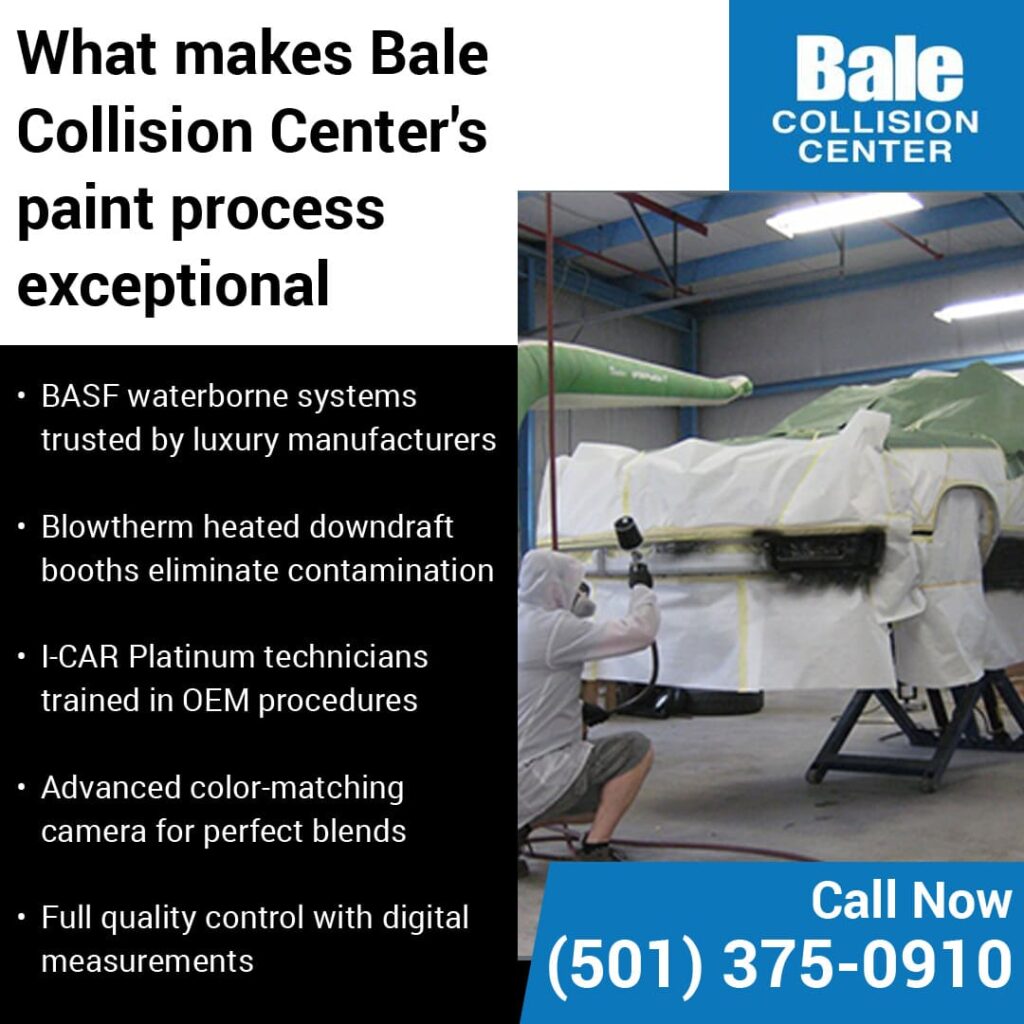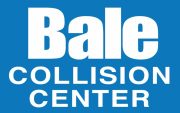Paint quality separates professional vehicle collision repair in Downtown Little Rock, AR, from substandard work that fails within months. At Bale Collision Center (Downtown), we’ve spent years refining our refinishing techniques that protect your investment long after you drive away from our shop. The difference lies in three critical areas: the materials we apply, the environment where application occurs, and the expertise of our certified technicians.
Our approach combines:
- BASF waterborne paint systems for superior color matching
- Blowtherm heated downdraft booths for contamination-free application
- I-CAR Platinum certified technicians for precision workmanship
These elements deliver results that meet manufacturer specifications while preserving your vehicle’s safety systems and warranty coverage.

The Role of Paint in Vehicle Restoration
According to industry data, 85% of collision repairs require paintwork. That refinishing either restores your vehicle to pre-accident condition or creates problems ranging from visible color mismatch to hidden corrosion that emerges years later. The process involves more than spraying color onto damaged panels. Modern vehicles demand precise paint thickness near radar sensors, UV-resistant clearcoats that prevent fading, and corrosion inhibitors that stop rust at welded seams.
Protecting Repaired Panels from Corrosion
Paint serves as the primary barrier preventing moisture and oxygen from reaching metal surfaces after collision damage. When vehicles suffer impact damage, the original protective coating breaks down. Without proper refinishing, exposed metal begins to corrode within weeks.
Collision damage often creates stress points where metal bends or welds join panels. These areas become vulnerable to rust formation. Professional refinishing seals these weak points using primer systems designed for adhesion and corrosion resistance.
Proper paint application extends panel life compared to substandard refinishing. The primer layer contains zinc compounds that actively prevent oxidation. This protection works even if the topcoat develops minor scratches.
Restoring Factory Appearance Standards
Paintwork after a collision must match the factory finish in color, texture, and gloss to preserve vehicle value. Mismatched repairs become obvious under sunlight and reduce resale value.
Vehicle manufacturers apply paint in controlled factory conditions using specific application parameters. Replicating these standards requires understanding the original process. Different manufacturers use varying basecoat formulations, clearcoat thicknesses, and orange peel textures.
Modern vehicles feature complex finishes including metallic flakes, pearl effects, and tri-coat systems. These finishes require specialized mixing and application techniques. For example, a standard solid color might need two coats. A tri-coat pearl finish requires five separate applications.
Protecting Advanced Safety Systems
Proper paint thickness ensures radar sensors, cameras, and electronic systems function correctly after auto collision repairs. Vehicles with advanced driver assistance systems depend on precise paint specifications near sensor locations.
Radar systems measure distances using radio waves that pass through paint. Thickness beyond manufacturer specifications disrupts signal accuracy. This can cause false warnings or system failures. Some manufacturers limit paint thickness in areas housing pre-collision sensors to maintain system performance.
Excessive paint thickness can also lead to adhesion problems. These include cracking, peeling, or delamination over time. OEM specifications balance corrosion protection with functional requirements. That’s why we measure paint thickness at multiple points on each repaired panel.
Bale Collision Center’s Advanced Paint Process
BASF Waterborne Paint Systems
We use BASF waterborne basecoats that reduce volatile organic compounds while delivering superior color matching. This system represents the most advanced refinishing technology available for auto collision repair work. The BASF waterborne system matches vehicle colors from the 1980s to today’s models. The water-based formula creates smoother finishes with less texture than older paint types.
BASF provides the exclusive paint for premium brands, including Bentley and Rolls-Royce. These manufacturers trust BASF because it matches their factory finishes exactly. Our auto collision center holds the required certifications and training to work on these high-end vehicles.
The system works in both hot and cold weather conditions. This means we deliver consistent quality year-round. Whether we’re painting your vehicle in July or January, the results remain consistent.
BASF Color Matching Camera Technology
The BASF camera reads vehicle paint at the molecular level. It analyzes color under multiple light sources to generate exact formulas. This technology accounts for fading, oxidation, and environmental wear that changes paint over time.
Standard color matching relies on paint code databases that assume factory-fresh finishes. A vehicle driven for years in the Arkansas sun develops a color shift. This makes database formulas inaccurate. The camera measures actual surface characteristics rather than theoretical values.
The device captures data in multiple wavelength ranges, including ultraviolet and infrared. This comprehensive reading identifies metallic flake orientation, pearl depth, and pigment concentration. The system then adjusts the formula to compensate for aging effects.
Color verification occurs through spray-out cards. Our technicians apply test samples before painting the vehicle. This physical comparison under natural daylight confirms formula accuracy. It prevents costly rework from color mismatches.
Blowtherm Heated Downdraft Spray Booth
Our auto collision center uses Blowtherm paint booths to keep dust and debris away from your vehicle during painting. The enclosed system filters air through three stages before it enters the booth. This prevents contamination that causes defects.
The booth pulls clean air from the ceiling, flows it down over your vehicle, and exits through the floor. This downward pattern carries overspray and dust away from fresh paint instead of blowing it across wet surfaces.
Temperature control occurs in two stages:
- Application phase: 72°F while technicians apply paint
- Curing phase: 140°F to speed drying
The controlled heat helps the paint dry evenly without creating bubbles or uneven spots.
Humidity control prevents moisture problems during painting. The system maintains ideal moisture levels in the air. Too much humidity makes paint dry slowly. Too little causes rough texture and poor bonding to the surface.
Quality Control and Final Inspection
We perform multi-point inspections before you pick up your vehicle. This verification process catches any issues while your car remains in our shop. It prevents the need for return visits.
Our inspection includes three critical checks:
- Color Matching Verification We check color matching under multiple light sources, including natural daylight, fluorescent, and LED lighting. Paint can look perfect under one type of light but show differences under another. Our technicians verify that the finish looks consistent in all lighting conditions before approving the work.
- Surface Quality Assessment Surface inspection identifies texture problems like orange peel, dry spray, dirt contamination, and other defects. We match the texture to your vehicle’s original finish. This ensures the repaired area blends seamlessly with the rest of your car.
- Paint Thickness Measurement We measure paint thickness on each repaired panel using specialized gauges. The readings must fall within the manufacturer’s specifications. This thorough inspection process sets our vehicle collision repair in Downtown Little Rock, AR apart from shops that skip these verification steps.
Understanding Paint Quality Standards
OEM Specification Compliance
Vehicle manufacturers publish specific paint requirements, including approved products, application methods, and thickness ranges. These specifications ensure repairs maintain factory standards for appearance and functionality.
OEM requirements change frequently as manufacturers release new models and update existing specifications. Our technicians use I-CAR’s OEM information database to access current manufacturer procedures. They check the requirements for every vehicle before beginning paintwork.
Paint Thickness Measurement Standards
Proper mil thickness prevents sensor interference while providing adequate corrosion protection. Factory paint measures 4-6 mils across primer, basecoat, and clearcoat layers.
We measure existing paint thickness before starting auto collision repairs to establish baselines. Vehicles with previous repairs may already have multiple paint layers approaching maximum acceptable thickness. If existing paint exceeds 10 mils, we remove material before applying new coatings.
Post-repair measurements verify compliance with OEM limits. Readings occur at standardized locations on each panel, documented with digital gauges that record measurements. This data becomes part of the permanent collision repair record.
Color Matching Accuracy Requirements
Industry standards require color matches to be virtually undetectable to the naked eye. Professional equipment measures color differences more precisely than what people can see.
The human eye can detect slight color variations depending on lighting and viewing angle. Professional repair standards aim for even tighter matches to make sure the paint looks consistent under all light sources, from showroom fluorescents to bright sunlight.
The Bale Collision Center Difference
72 Years of Family-Owned Service
Since 1952, three generations have refined our collision repairprocesses while maintaining quality standards. We’ve transitioned through multiple paint technology eras, from lacquer requiring extensive polishing to modern waterborne systems. Each transition required equipment investment and technician retraining. Our commitment to current methods rather than outdated practices separates us from shops using older technology.
I-CAR Gold and Platinum Certifications
Our auto collision center holds I-CAR Gold certification, while our technicians maintain I-CAR Platinum status. These credentials mean your vehicle receives collision repairs using the latest manufacturer-approved methods and techniques.
I-CAR certification makes sure our entire team stays current on new vehicle technologies. As cars become more complex with advanced sensors and electronic systems, ongoing training protects your safety and maintains your vehicle’s warranty coverage.
Our paint technicians hold Platinum credentials, the highest level of individual certification in the collision repair industry. This expertise means your paintwork meets the exact specifications required by your vehicle’s manufacturer, protecting both appearance and resale value.
Complete Service Integration
We handle all aspects of vehicle collision repair in Downtown Little Rock, AR, through single-point management. This integration prevents communication gaps that cause delays or quality issues.
Paintwork depends on proper panel alignment and surface preparation. Frame damage must be corrected before refinishing begins. Otherwise, paint hides underlying problems. From initial estimates and frame straightening to panel replacement, glass installation, and final paintwork, we coordinate every service your vehicle needs. You work with one team throughout the entire repair process. You receive consistent updates and answers to your questions.
At Bale Collision Center, we work with State Farm, Allstate, Liberty Mutual, USAA, Nationwide, Safeco, AAA, and Hanover through Direct Repair Programs. These partnerships streamline claims processing while maintaining quality standards that benefit customers.

Frequently Asked Questions
How soon can I drive my car after the paintwork is complete?
You can drive your vehicle immediately after pickup. The curing process in our heated booth fully hardens the paint before delivery, so it’s safe to drive in all weather conditions right away.
Can you repair my vehicle if it has aluminum or high-strength steel panels?
Yes, we’re equipped and certified to work on modern vehicle materials, including aluminum and high-strength steel. Our technicians receive specialized training for these advanced materials.
Do I need to wait before washing my car after paintwork?
You can wash your vehicle immediately after pickup using touchless or hand washing methods. Avoid automated car washes with brushes for the first 30 days to allow the paint to fully cure.
How do you handle paintwork near backup cameras and sensors?
We measure paint thickness carefully in sensor areas to maintain manufacturer specifications. Excessive thickness can interfere with radar and camera systems, so we follow strict OEM guidelines.
Schedule Your Auto Collision Repair Estimate Today
Quality paintwork makes the difference between a proper repair and ongoing problems. At Bale Collision Center, we restore your vehicle using manufacturer-approved methods that protect both appearance and value.
Call (501) 375-0910 or emailbccdowntown@baleautomotive.comtoday to schedule your free estimate and discuss your vehicle’s specific repair needs. We’ll answer your questions and work directly with your insurance company to make repairs as smooth as possible.
